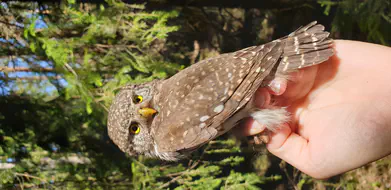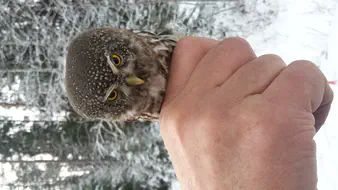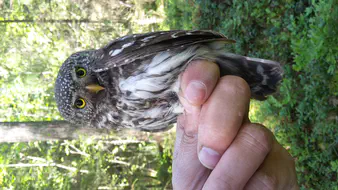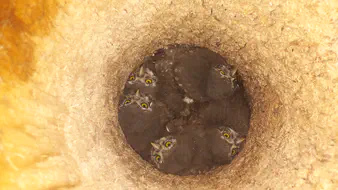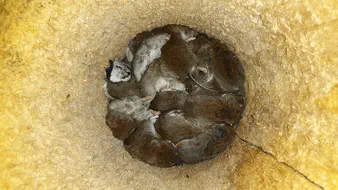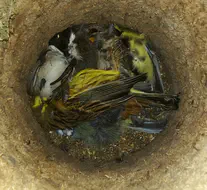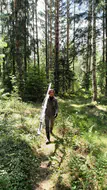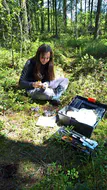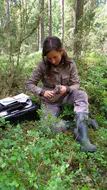Food hoarding of an avian predator under food limitation and climate change
 Art by Martina Cadin
Art by Martina Cadin
Ph.D. thesis: LINK
Funding: University of Turku Graduate School (January 2017 - December 2020)
Background
Hoarding behaviour (storing food for later use) has evolved to reduce the risk of starvation when resources are scarce.
Aims
In this thesis, I studied the food-hoarding behaviour of Eurasian pygmy owls (Glaucidium passerinum) under spatiotemporally varying environmental conditions. I aimed at investigating differences between age and sex classes, the effect of intra-specific competition, predator responses to the abundance of the main prey, and the effect of climate on the behaviour.
Data
The data were collected starting in 2003 by Prof. Emeritus Erkki Korpimäki in western Finland, where the abundance of voles fluctuates in three-year population cycles. The long-term individual-based dataset included detailed information on each of the food store content in the study area and on the individual that collected the food store.
Main findings
- The number of stores per year and the biomass of prey items stored increased with vole abundance. Females and yearlings had larger and heavier stores than males and adults, respectively. (Masoero et al. 2018 Behav Ecol Sociobiol)
- Predator responses (Masoero et al. 2020 Oecologia):
- Functional response - At times of low vole abundance, adult owls stored more small birds and fewer small mammals than yearlings. Females stored more small mammals than males, and showed a tendency to store fewer birds.
- Numerical response - The numbers of yearlings of both sexes and adult females increased with increasing vole abundance.
- Competition - Owls were less likely than expected to have a neighbour of the same class (sex or age) when the main prey was abundant, suggesting high sex- or age-specific competition. Food stores, however, were mostly larger when the nearest neighbour was of the same sex. In years of low vole abundance, increasing conspecific density reduced the total prey number stored by an owl, suggesting a high cost of competition. (Koivisto, Masoero et al. 2024 Ornis Fennica)
- Climatic conditions - The thesis also reveals a strong effect of autumn and winter climate on food-hoarding pygmy owls and on the quality of the stored food. Pygmy owls may be partly able to adapt to climate change by delaying the initiation of food-hoarding. Numerous weather variables nonetheless affect their hoarding behaviour and the perishability of the cached food. Rotten food may be of poor quality and may be connected to a lower recapture probability. In female owls, rotted food hoards, often consumed, are linked with a lower future recapture probability, presumably indicating that they either die or emigrate permanently from the area. (Masoero et al. 2020 GCB)
Conclusions
Detailed knowledge of age- and sex-related differences in hoarding behaviour under fluctuating abundances of the main prey can thus provide a fundamental tool to better understand the dynamics of a predator population and its response to climate change.
Other publications of the project:
- D Baroni, G Masoero, E Korpimäki, C Morosinotto, T Laaksonen (2021) Habitat choice of a secondary cavity user indicates higher avoidance of disturbed habitat during breeding than during food-hoarding, Forest Ecology and Management, 483, 118925.
- B Class, G Masoero, J Terraube, E Korpimäki (2021) Estimating the long-term repeatability of food-hoarding behaviours in an avian predator, Biology Letters, 17 (7), 20210286.
- E Korpimäki, K Hongisto, G Masoero, T Laaksonen (2020) The difference between generalist and specialist: the effects of wide fluctuations in main food abundance on numbers and reproduction of two co‐existing predators, Journal of Avian Biology, 51 (8).
Some photos from the fieldwork:
Collaborators
Prof. Emeritus Erkki Korpimäki, University of Turku, Finland
Prof. Toni Laaksonen, University of Turku, Finland. Research group website.
Dr. Chiara Morosinotto, Novia University, Finland
Dr. Barbara Class, CEFE CNRS Montpellier, France
Dr. Daniele Baroni, University of Turku, Finland
Dr. Elina Koivisto, University of Turku, Finland
Dr. Eric Le Tortorec, University of Jyväskylä, Finland
